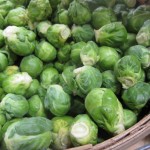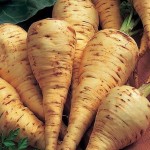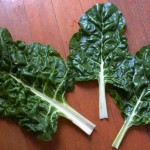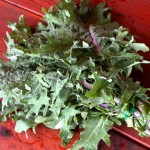 Raw Butternut Squash Salad with Cranberry Dressing
Raw Butternut Squash Salad with Cranberry Dressing
Butternut squash is a great source of Heart-health-supportive carotenes. This winter squash is usually cooked, but also is tasty when eaten raw.
INGREDIENTS
½ cup pecans, toasted and chopped
½ cup fresh or frozen cranberries, rinsed
¾ cup fresh orange juice
1 tablespoon minced ginger
3 tablespoons olive oil
1 tablespoon honey
sea salt and pepper to taste
1 ½ pounds butternut squash
DIRECTIONS
1. Preheat the oven to 300 degrees. Toast the pecans for 15-20 minutes, or until fragrant. Allow to cool then chop coarsely. Set aside.
2. Combine cranberries, orange juice, and ginger in a small saucepan over medium-low heat. Cover and cook, stirring occasionally, until the berries have begun to break, about 10 minutes.
3. Remove from heat and add the oil, honey, and some salt and pepper. Sit until well combined.
4. Meanwhile, grate the butternut squash by hand or in a food processor. Transfer the squash to a large bowl, add the warm cranberry dressing and toss to combine.
5. Top the salad with the toasted pecans. Serve warm or at room temperature.
Serves 8
 Roasted Brussels Sprouts with Toasted Walnuts and Dijon Mustard
Roasted Brussels Sprouts with Toasted Walnuts and Dijon Mustard
Walnuts provide healthy fats that are necessary to support a healthy cardiovascular system. They are toasted in a low heat to preserve their healthy fats. Walnuts contain arginine, an amino acid that relaxes the blood vessels and prevents against build-up in the arteries. Brussels sprouts are nutrient dense vegetable that is great for all around health. Roasting them brings out their natural sweetness.
I love Brussels sprouts, and this is one of m favorite ways to eat them. It is worth it to go buy a Belgium endive – the crispness and coolness of the endive with the warm sprouts is delightful!
INGREDIENTS
Vinaigrette:
3 tablespoons white wine vinegar
2 tablespoons water
1 tablespoon Dijon mustard
¼ cup minced shallots
½ teaspoon sea salt
¼ teaspoon freshly ground black pepper
3 tablespoons olive oil (or flax seed oil)
Brussels Sprouts:
½ cup walnuts, halved lengthwise
2 tablespoons unsalted butter, cut into pieces
1 pound Brussels sprouts, trimmed and halved lengthwise
1 teaspoon sea salt
6 ounces spinach (or frisee), cut into bite sized-pieces
1 pound Belgian endive, cut crosswise into ½-inch slices
DIRECTIONS
Vinaigrette:
Whisk together vinegar, water, mustard, shallots, salt, and pepper in a small bowl, then add oil in a small stream, whisking to emulsify.
Salad:
1. Preheat oven to 200 degrees. Lay the walnuts on a sheet pan and toast in the oven for about 15 minutes, or until fragrant. Set aside and raise the heat in the oven to 350 degrees.
2. Melt the butter in a large, shallow baking pan (1-inch deep) in lower third of oven, about 3 minutes. Toss sprouts in a pan with butter and salt. Arrange sprouts, cut side down in the baking dish in 1 layer and roast in lower third of oven until undersides are golden, about 20 minutes.
3. Whisk vinaigrette then transfer warm sprouts to a large bowl. Toss with the walnuts, spinach (or frisee), endive and enough vinaigrette to coat. Serve immediately.
Serves 6
 Roasted Onion Salad
Roasted Onion Salad
Roasting and caramelizing onions brings out their natural sweetness. Onions, like other foods in the allium family, are helpful in promoting heart health.
INGREDIENTS
Onions:
1 tablespoon ghee or coconut oil, melted
½ teaspoon sea salt
½ teaspoon black pepper
3 medium yellow onions, trimmed and cut into ¼ -inch sauté slices
6 medium shallots, trimmed and cut into half
4 medium leeks, trimmed, cleaned, and sliced into half-moons
8 sprigs fresh thyme
Salad:
1 tablespoon olive oil
2 teaspoons fresh lemon juice
1 teaspoon minced garlic
1 teaspoon coarse mustard
½ teaspoon sea salt
½ teaspoon freshly ground black pepper
2 medium Belgium endive (optional)
5 cups spinach, bite-sized pieces
¼ cup thinly sliced scallions (green onions)
DIRECTIONS
Onions:
1. Put oven rack in upper third of oven and preheat to 400 degrees.
2. Whisk together the melted ghee or oil, salt, and pepper in a large bowl. Add the onions, shallots, and leeks, tossing to coat. Spread onion mixture in an even layer on a parchment paper-lined baking sheet and scatter thyme leaves on top. Cover with another sheet of parchment paper then foil on top, crimping edges all around to seal and form a package.
3. Roast until very tender, about 1 hour. Carefully remove top sheet of foil and parchment paper and turn on broiler. Remove bottom layer of parchment paper and spread the onions evenly on the baking sheet. Broil onion mixture about 5-6 inches from heat until onion tops are browned and caramelized-2-5 minutes. Check frequently, removing pieces as they brown. Remove and discard thyme sprigs.
Salad:
1. Whisk together the olive oil, lemon juice, garlic, mustard, salt, and pepper in a large bowl.
2. Trim the endive and cut into 1/2 –inch slices.
3. Just before serving, add endive to dressing along with spinach and scallions, tossing until lightly coated. Season with salt and pepper. Place on a serving platter and top with warm onion mixture.
Serves 12
 Roasted Parsnip Bread Pudding
Roasted Parsnip Bread Pudding
Serves 6 – 8
Parsnips give an earthy dimension to this savory bread pudding that melds cubes of brioche, grated cheese, and thyme. The vegetarian dish is yummy enough to sub for traditional stuffing. Assemble the night before, and bake it the day of the meal.
INGREDIENTS:
1 pound parsnips, peeled (optional), and cut into ½-inch pieces
olive oil for drizzling
sea salt and freshly ground black pepper
1 ounce (2 tablespoons) unsalted butter, plus 3 tablespoons melted, plus more for dish
2 large leeks, white and pale green parts only, halved, thinly sliced and rinsed well (about 3 cups)
1/3 cup dry white wine
2 tablespoons chopped fresh thyme
2 cups heavy cream
5 large eggs
1 cup finely grated Parmesan cheese
1 loaf brioche, crust removed and bread cut into 1-inch cubes (you can use other bread if you so desire)
DIRECTIONS:
1. Preheat oven to 425 degrees. Drizzle parsnips with oil, and season with salt and pepper. Arrange on a rimmed baking sheet. Roast, shaking occasionally, until caramelized and tender, about 20 – 25 minutes. Let cool. Reduce oven heat to 375 degrees.
2. Heat 2 tablespoons butter over medium heat in a medium sauté pan until melted. Add leeks and cook, stirring occasionally, until tender, about 5 minutes. Remove from heat; add wine and return to heat. Let simmer until reduced, 1 – 2 minutes. Add thyme, and remove from heat. Stir in roasted parsnips.
3. Whisk together melted butter, heavy cream, eggs, and ¾ cup Parmesan cheese in a large bowl. Season with salt and pepper. Add leek-parsnip mixture, then fold in bread (mixture can be refrigerated overnight).
4. Butter a shallow 2–quart baking dish, and pour parsnip mixture into dish. Cover loosely with parchment paper then foil. Bake until golden brown and puffed, about 50 minutes. Remove parchment paper and foil. Sprinkle with remaining ¼ cup Parmesan cheese, and return to oven. Bake for 10 minutes more. Let stand 5 minutes before serving.
 Swiss Chard and Caramelized Onions
Swiss Chard and Caramelized Onions
Serves 4
Caramelized onions add a sweet note to the chard and capers, and kalamata olives add a salty bite in this simple dish.
We now know that Swiss chard is one of the healthiest vegetables, rich in folate, vitamins A, K, and C, magnesium, potassium, iron, and fiber. Store chard in a perforated plastic bag in the vegetable crisper of the refrigerator for up to 3 days. For ease of storage, you might want to cut off the stalks and store separately.
INGREDIENTS:
1 large onion, sliced into half-moons
2 tablespoons olive oil
1 teaspoon brown sugar or sweetener of choice
1 bunch chard, rinsed and chopped
¼ cup kalamata olives
2 tablespoons capers
½ teaspoon sea salt, or to taste
freshly ground black pepper, to taste
1 lemon, for juice
DIRECTIONS:
- In a cast iron skillet or just a heavy skillet, cook the onions in the olive oil over medium-high heat until they begin to brown. Stir in the brown sugar and continue to cook for a few minutes more, until the onions caramelize.
- When the onions are brown and tender, stir in the chard and olives. Cook until chard is slightly wilted. Stir in the capers and salt and continue cooking until the chard is completely wilted, about 3 minutes more. Season with black pepper and squeeze lemon juice over top.
 Kale Salad with Asian Flavors
Kale Salad with Asian Flavors
6 – 8 servings
As a salad green, kale is quite compatible with Asian flavors. Kale is among the most highly nutritious vegetables. It is an excellent source of carotenes, vitamins C and B6, and manganese. Kale supplies more than 70% of the RDI for vitamin C, with only 20 calories. Also, it is a good source of dietary fiber, as well as many minerals, including copper, iron, and calcium. As a member of the cabbage family, kale exhibits anti-cancer properties.
INGREDIENTS:
1 bunch kale, stemmed and cut into bite-sized pieces
2 cups thinly shredded cabbage
4 carrots, either grated or cut into small, thin rounds
¼ cup or so of crushed peanuts or cashews
freshly ground black pepper to taste
Sesame-Ginger Salad Dressing (recipe follows)
DIRECTIONS:
1. In a large serving bowl, sprinkle a pinch of salt on the kale and a drizzle of olive oil, massage the kale with your hands, until it become tender; make sure to stop before it gets mushy.
2. Combine kale with the remaining ingredients in the serving bowl. Toss together with the dressing and serve.
SESAME DRESSING
½ cup olive oil
¼ cup balsamic vinegar
2 teaspoons low-sodium soy sauce
2 cloves garlic, minced
2 tablespoons brown sugar or honey
2 tablespoons ginger, peeled, minced
1 teaspoon toasted sesame oil
2 tablespoons water
DIRECTIONS:
1. Whisk all ingredients together except the water. When completely emulsified, whisk in the water. It is ready to use!
 Green Pizza
Green Pizza
6 servings
Arugula adds a slightly bitter, peppery taste. Store arugula in loosely sealed plastic bags in the crisper section of the refrigerator and use within 2 – 3 days, as it is extremely perishable. Wash thoroughly before using to remove any grit, and carefully dry using a salad spinner or on absorbent towels.
It is also called rocket, the French call it roquette, and Italian call it rucola. It is rich in vitamins A and C, and iron.
INGREDIENTS:
1 pound pizza dough (recipe below)
1 onion, (or more), sliced
5 ounces or more arugula, tough stems removed (about 6 cups); you can also use a mix of spinach and arugula, or just spinach if you want a milder flavor.
Pinch of sea salt
Freshly ground pepper to taste
½ cup prepared pesto (optional, but so delicious)
1 cup shredded mozzarella cheese (I use whatever cheese I feel like having)
DIRECTIONS:
1. Position oven rack in the lowest position; preheat oven to 450 degrees. Coat a baking sheet with olive oil.
2. Roll out dough on lightly floured surface about the size of the baking sheet. Transfer to baking sheet. Bake until puffed and lightly crisped on the bottom, about 8 – 10 minutes.
3. Meanwhile, in a skillet, heat a little olive oil and add the onions; sauté until caramelized, about 8 – 10 minutes. I like to use more than 1 onion, especially if I am not using pesto.
4. Stir in the arugula and/or spinach, stirring until wilted. Season with sea salt and pepper.
5. Spread the pesto evenly over the crust top (if using), add the onions, spreading them evenly, then add the greens. Sprinkle with cheese. Bake until crispy and golden, and the cheese is melted, about 8 – 10 minutes.
PIZZA DOUGH
Makes 1 large pizza
Ingredients:
1 package dry yeast
1 teaspoon honey
1 cup warm water (105 – 115 degrees)
3 cups flour of choice
1 teaspoon sea salt
1 tablespoon olive oil, plus more for brushing
DIRECTIONS:
- Dissolve yeast and honey in a small bowl with ¼ cup warm water.
- In a mixer with the dough hook, combine flour and salt. Add the oil and yeast and ¾ cups warm water. Mix on low until dough comes away from the sides, about 5 minutes.
- Turn it out onto a floured surface and knead for another 2 – 3 minutes, until smooth and firm. Cover with a damp towel and let rise for 30 minutes.
- Roll out dough on a lightly floured surface and knead into a ball. Cover with a damp towel and let rise for another 15 – 20 minutes.
- At this point you can cover the dough with plastic wrap and store in the refrigerator for up to 2 days, or lightly flour a surface and roll out the dough to fit a baking sheet (or as close as you can get it). Place on a lightly oiled baking sheet and continue as above recipe instructs.
 Glazed Carrots and Parsnips
Glazed Carrots and Parsnips
The parsnip is closely related to carrots and celeriac, and has been utilized as food for thousands of years. The parsnip has a unique, sweet-earthy flavor like that of no other vegetable, and it also has an interesting nutrition profile, being especially high in potassium, folic acid, and vitamin C. While you may need to parboil parsnips in order to use them in some other way (for example, in a mash or baked in a gratin) boiling generally isn’t the beat treatment for them, as they become waterlogged and unpalatable.
To steam parsnips, place peeled 2-inch rounds of parsnip in a steamer basket over boiling water. Cover and cook until tender, about 10 minutes or less. To roast them, half them lengthwise then place in a large roasting pan in a single layer and drizzle liberally with olive oil, tossing to coat. Cook in a 400 degree oven for 30 – 40 minutes, depending on size or until tender and golden brow. Toughness of a parsnip is due to storing them too long. Parsnips will keep, refrigerated, in loosely sealed bag for up to 1 week.
INGREDIENTS:
¼ cup butter
4 large carrots, cut into 3-inch by ½-inch pieces
4 large parsnips, cut into 3 inch by ½-inch pieces
¾ cup orange juice
¾ chicken or vegetable stock
2 tablespoons lemon juice
sea salt and freshly ground black pepper to taste
3 tablespoons chopped chives (if you don’t have chives you can use green onions, chopping the green part finely)
DIRECTIONS:
- Melt butter in a large skillet over medium heat.
- Cook and stir carrots and parsnips in melted butter until lightly browned on edges, up to 8 – 10 minutes.
- Stir in orange juice, stock, lemon juice, sea salt and pepper onto the carrots and parsnips. Bring to a boil, reduce heat to low and cover. Simmer until liquid reduces to a syrup, about 10 minutes. Stir often.
- Season with more salt and pepper, if needed; sprinkle with chives or green onions.
 Chicken Noodle Soup with Kale
Chicken Noodle Soup with Kale
Serves 6 – 8
This is a quick cooking soup, which gets a hearty boost from kale. You can certainly add spinach as well.
INGREDIENTS:
2 tablespoons olive oil
1 tablespoon minced garlic
1 medium onion, diced
sea salt and pepper to taste
1 sprig thyme
7 cups chicken stock
1 ½ cups dry noodles like mini shells, or your choice (I like a rainbow pasta I get at the health food store)
1 bunch kale, tough stems removed, leaves sliced into thin ribbons
1 ½ cups shredded, cooked chicken
1 tablespoon low sodium soy sauce or to taste
juice of 1 lemon about 2 tablespoons, or more to taste
DIRECTIONS:
- Warm the olive oil in a large pot over medium heat. Add the garlic and onion and cook, stirring, until slightly softened and fragrant, about 4 minutes. Season with sea salt and pepper.
- Add the thyme sprig and 6 cups stock, and turn the heat up to high. When broth begins to boil, add the noodles and kale. Reduce heat to medium, and simmer for about 10 minutes, until the pasta is mostly cooked through but al dente.
- Stir in chicken and cook a few minutes more to warm through. If you prefer a looser soup, add the remaining 1 cup of stock and cook for another minute or so until simmering again.
- Add the soy sauce and lemon juice, season to taste, adding more salt, pepper or lemon juice if needed. Serve hot.
 Spinach or Arugula and Miso Pesto
Spinach or Arugula and Miso Pesto
The twist on this classic pesto recipe is substitution of spinach or arugula for the customary basil.
Miso, a salty paste of fermented soybeans (available in health foods stores and in health section of regular markets), makes a good non-dairy stand-in for Parmesan cheese. It is a good source of many minerals, including zinc, manganese, iron, and copper, as well as vitamins B6 and B12, and protein and dietary fiber. It has the same cancer fighting effects as other soy foods.
Ingredients:
10 – 12 ounces spinach or arugula
1 ½ cups firmly packed parsley leaves
½ cup pine nuts or walnuts
2 tablespoons olive oil
1 – 2 tablespoons lemon juice to taste
2 tablespoons white miso, more or less to taste
freshly ground black pepper to taste
DIRECTIONS:
- Steam the greens until just wilted. When cool enough to handle, squeeze out as much of the moisture as possible.
- Combine greens with the remaining ingredients in the food processor. Process until the mixture is coarsely pureed. Use at once or refrigerate in an airtight container, where it will keep up to 2 – 3 days.
- I like to use this pesto on the Green Pizza recipe. I cook everything first then add the pesto when the pizza is out of the oven, so the cooking process doesn’t destroy the good bacteria in the miso that is so important for the health of our GI tract (our gut!).
